MARIANI’S
Virtual Gourmet
July
22, 2018
NEWSLETTER
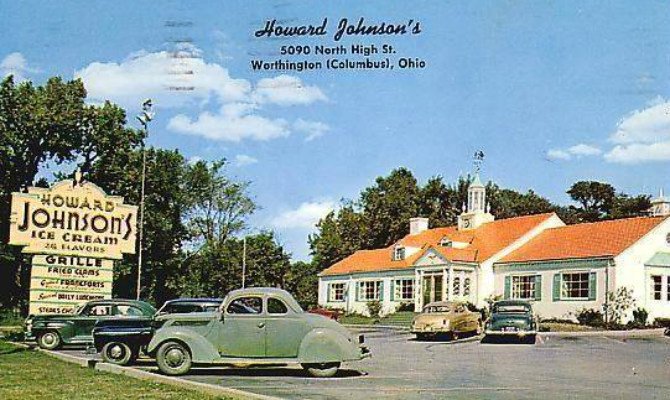
IN THIS ISSUE
EATING AROUND BRUGES
By John Mariani
NEW YORK CORNER
CLAY
By John Mariani
NOTES FROM THE WINE CELLAR
CASTELLO BANFI BROUGHT SENSE TO TUSCANY,
THEN INNOVATION OF ITS OWN
By John Mariani
❖❖❖
EATING AROUND BRUGES
By John Mariani
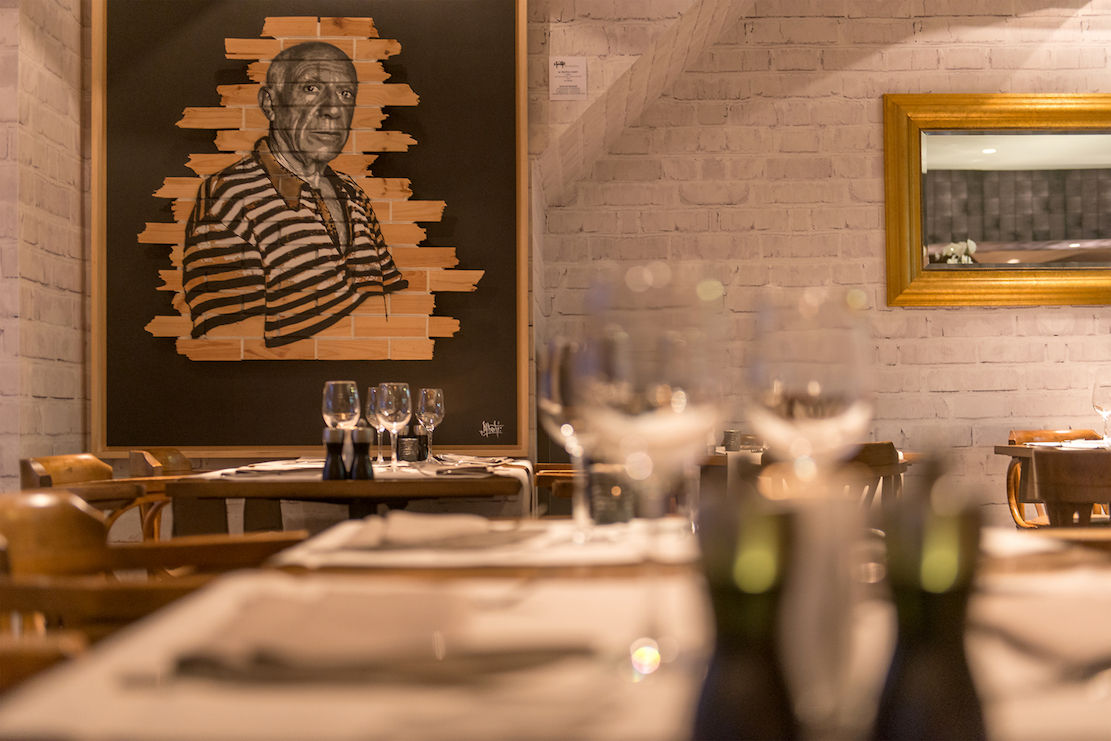
Christophe
0ne might be quite content eating out in a charming small city like Bruges, in northwest Belgium, by hopping from one local eatery to another for Belgian waffles, frites and mussels, visit some brew pubs or even the Michelin-starred restaurants (whose food is mostly French). But there are a number of places that have struck a balance of tradition and modernity on their menus. Others have adapted a more global approach of a kind you’ll find throughout Europe right now. Here are some of those I enjoyed most on a trip this spring.
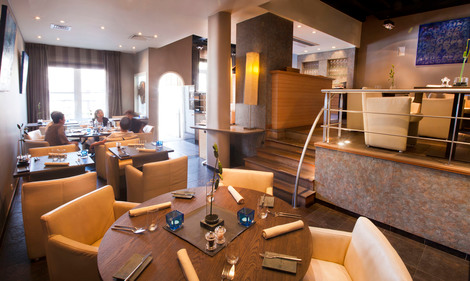 DE VISTRO BY DE VISSCHERIE
DE VISTRO BY DE VISSCHERIE
Vismarkt 8
32-50-33-0212
“Vistro”
is a Belgian play on the word “bistro” and the
visscherie
refers to its location right across from the city’s
Fish Market, so you can be absolutely sure of the
freshness of what is served each night, which is
actually only four days a week. This has
been a favorite of locals for 40 years now, under the
ownership of Tillo Declercq.
the
ownership of Tillo Declercq.
Behind a charming old white
façade there is a sleekly modern, very colorful
two-tiered dining room done in taupe and gray, with
good table settings and flowers. Very
light music plays pleasantly in the background. As
everywhere, the staff speaks perfect English and is
particularly good at recommending wines to go with
Chef Kevin Wiebouw’s contemporary Belgian cuisine.
The four-course chef’s menu is a
steal at 45 euros and you’ll get a good
representation of his strength, which, as you might
have guessed, is seafood (there is also a seafood
menu at €58). We began with a glass of a sparkling
wine called Entre Deux Monts (€45) while enjoying an amuse of
artichoke puree and dense brown bread. Lightly
smoked eel melded well with Belgian duck foie gras
and salad greens, while the sweet grey shrimp of the
region were poached and peppery, and stuffed with a
cream sauce. Very
lightly smoked wild salmon was a superb example from
the rivers of Scotland.
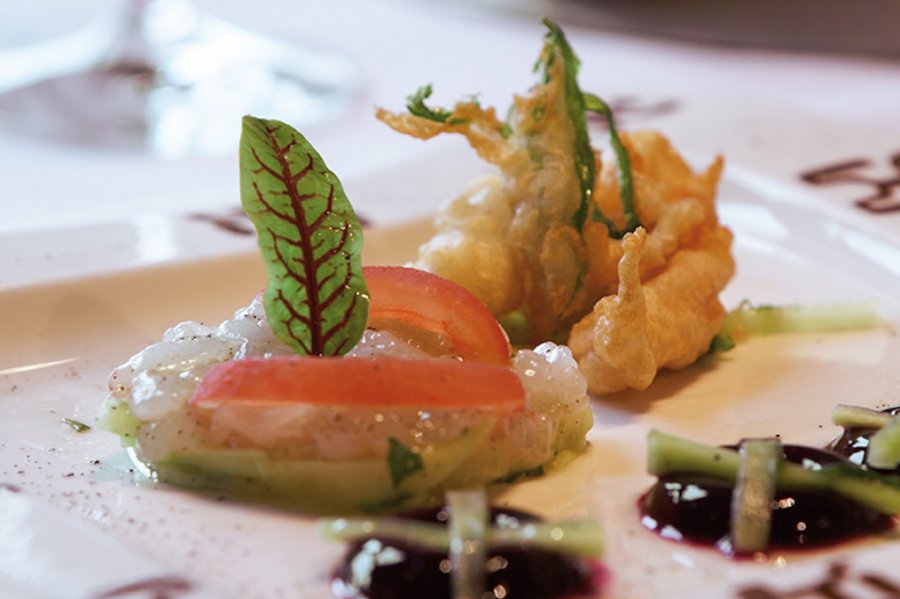 Since this
was May, the white asparagus were in full flourish,
so I ate them every chance I got. At Vistro, they
came with Spanish bellota ham
and
a glass of Wijndmein Aldeneyck Pinot Gris 2015
(€47.50 by the bottle), whose tang went beautifully
with the salty ham.
Skrei is a gray cod very limited in its
season, fished north of Norway, so it’s a fine, fat,
fleshy fish, here further graced with a foamy shrimp
and white asparagus infusion with an eggplant mash
and potato puree. For dessert the ripest of
strawberries were served with a chocolate mousse.
Since this
was May, the white asparagus were in full flourish,
so I ate them every chance I got. At Vistro, they
came with Spanish bellota ham
and
a glass of Wijndmein Aldeneyck Pinot Gris 2015
(€47.50 by the bottle), whose tang went beautifully
with the salty ham.
Skrei is a gray cod very limited in its
season, fished north of Norway, so it’s a fine, fat,
fleshy fish, here further graced with a foamy shrimp
and white asparagus infusion with an eggplant mash
and potato puree. For dessert the ripest of
strawberries were served with a chocolate mousse.
The meal
was quite light with just the right amount of fat in
the prime ingredients, demonstrating how Belgian’s
young chefs are showing restraint while showing off
their innovative talents.
Open for lunch and dinner Thurs.-Sun.
CHRISTOPHE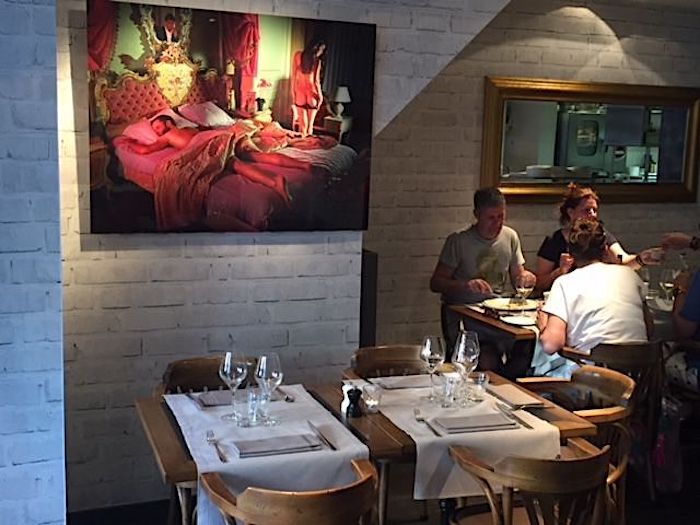
Garenmarkt 34
50-34-4892
One of Christophe’s two dining
rooms’ walls is hung with a curious, garishly
colored photo of two people, their backs to one
another, who may or may not have just had sex, while
across from it in the next room is a photo of
Picasso looking shocked, a winking quirkiness that
sets the tone at Christophe, a very popular spot for
a cross-section of young Brugeians and travelers who
come for first-rate, updated Belgian fare.
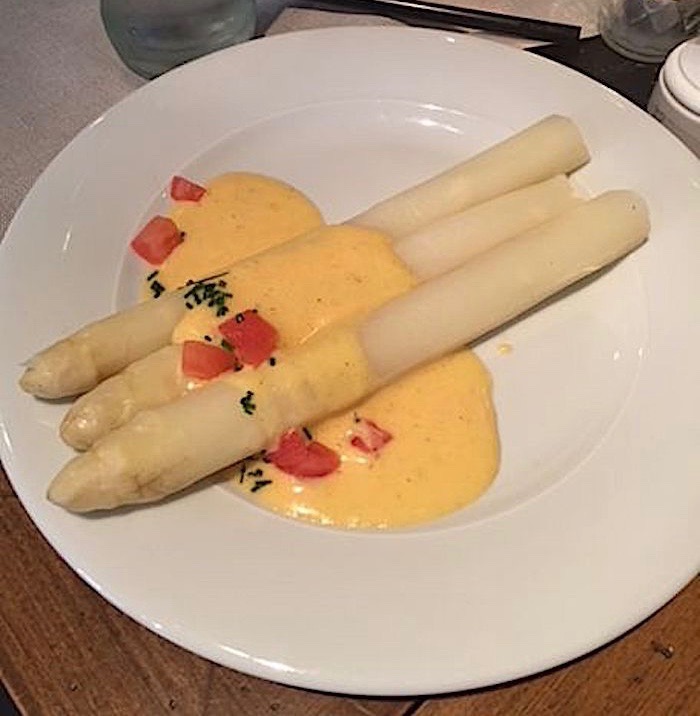 They bring
you a little bite of carrots with a Bearnaise sauce,
which was a nice touch with the Negroni cocktail I
ordered. The
obligatory shrimp croquettes (€17) were very crunchy
and tender inside, while the white asparagus with a
mousseline (€20) had all the sweetness of the season
in them.
They bring
you a little bite of carrots with a Bearnaise sauce,
which was a nice touch with the Negroni cocktail I
ordered. The
obligatory shrimp croquettes (€17) were very crunchy
and tender inside, while the white asparagus with a
mousseline (€20) had all the sweetness of the season
in them.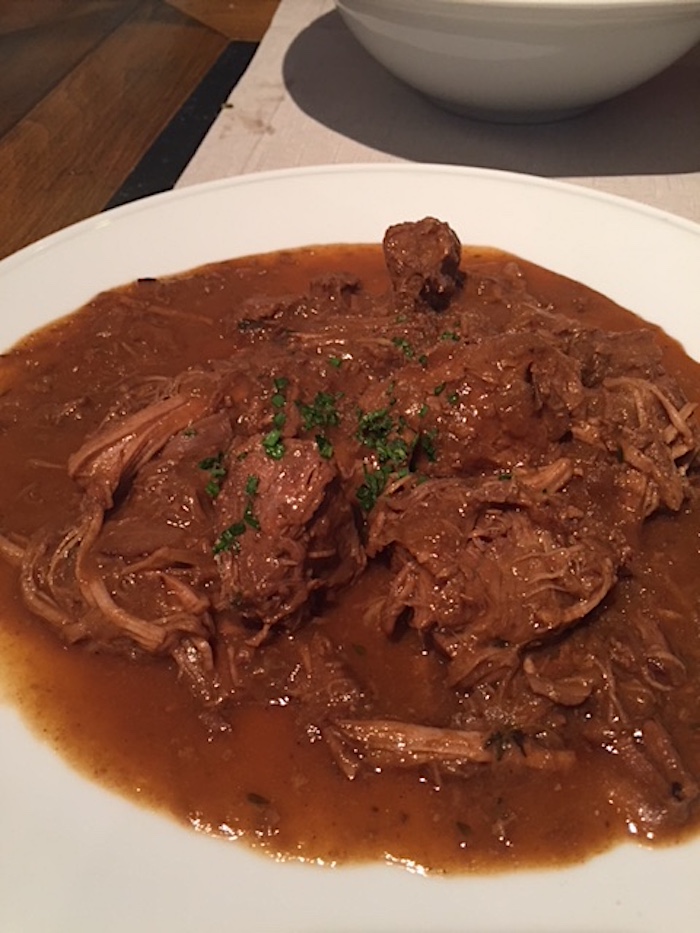
There are a lot of
straightforward grilled meats on the menu, including
an Irish ribeye in Cognac-laced pepper sauce (€29).
Crispy baked sweetbreads were a special that
evening, served simply with potato, and veal came in
a Viennese style with well-buttered spaghetti (€28).
There was also a seafood waterzooi
(€28), whose sauce of egg yolks and cream married
marvelously well to the morsels of
seafood—apparently, the way this classic was
originally made. They also serve one of the best
versions of carbonnade (right)—here called stoverij—I’ve
had: a steaming plate of beef stew, intensely
flavorful from being made with dark Belgian beer
(€29). The
Belgian frites are as plump and crisp as any in
Bruges.
Desserts
are equally traditional, from a fine platter of fat
profiteroles (€8.50) to a chocolate mousse (€8.50).
Open for dinner Thurs.-Mon.
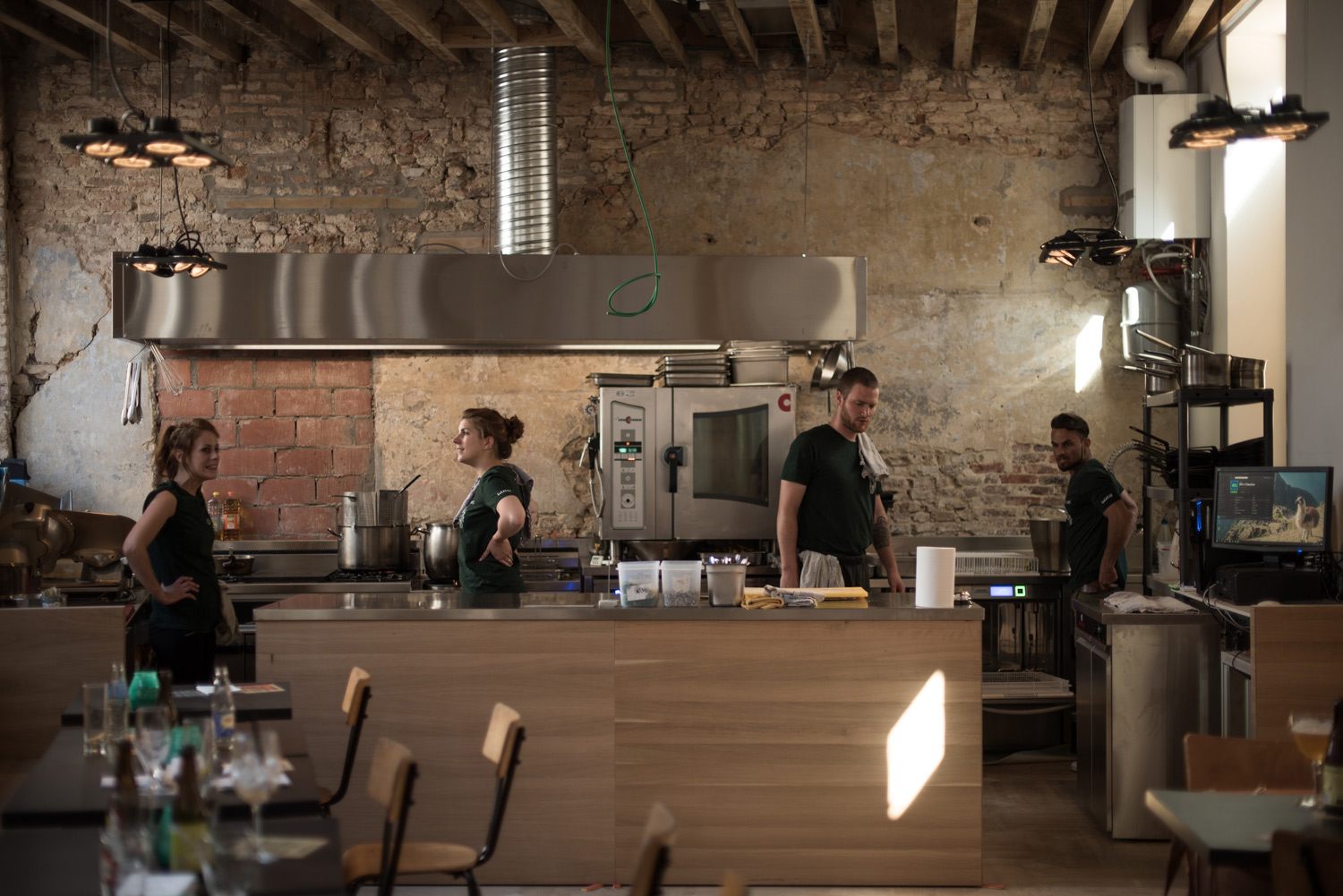 DE REPUBLIEK
DE REPUBLIEK
Sint-Jakobsstraat 36
50-73-4764
For a place with such a
Millennials’ look, De Republiek actually serves some
serious Belgian food, along with global everything,
within a very casual atmosphere. Actually it’s also
a very old restaurant that’s been restored to its
current bistro-style modernity. On a side
street off the Grand Market, the huge space is
within what was built as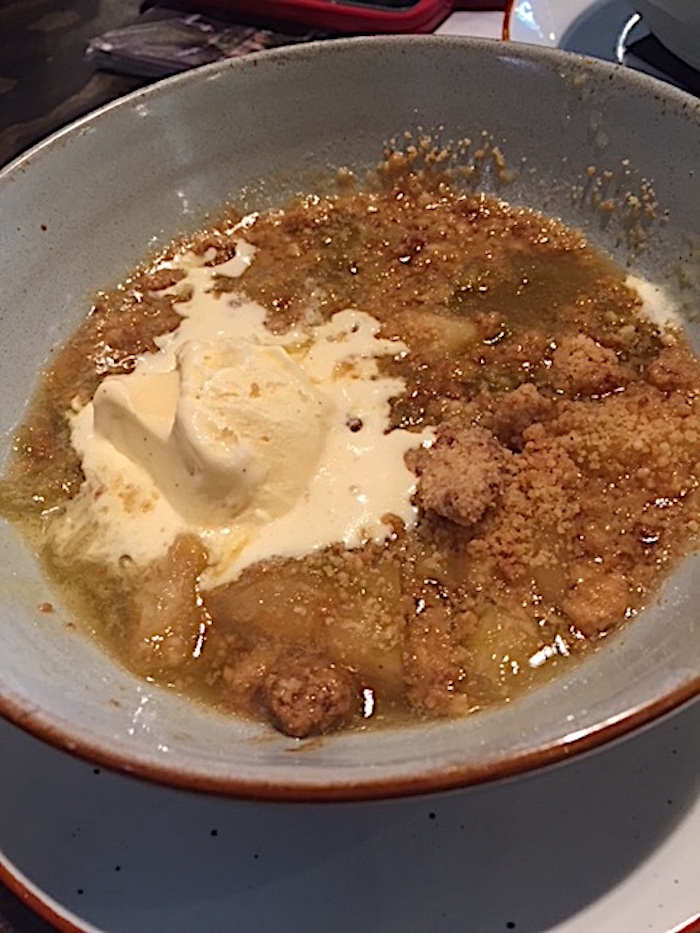 a butter
house in 1580 and was transformed over the centuries
into a concert hall in 1830, and in the 20th century
a movie theater. Today the structure houses not only
the restaurant but sections devoted to film, art and
public debates on culture.
a butter
house in 1580 and was transformed over the centuries
into a concert hall in 1830, and in the 20th century
a movie theater. Today the structure houses not only
the restaurant but sections devoted to film, art and
public debates on culture.
The menu ranges widely, from a
very well-rendered and spiced beef tartare (€19.50)
with a salad to a chicken vol-au-vent (€20); beef
carpaccio (€19) and “green” vegetarian burger (€17)
to an array of tapas at night (€8-12). We had the vis van de dag—fish
of the day from the North Sea—a grilled fillet with
poached vegetables (€21). Best of all was a shank of
Iberian ham (€20) cooked slowly like osso buco
surrounded by stewed vegetables and sweet potato—as
hearty and soulful a dish as you’ll find in town.
For dessert
go with the chocolate crumble with grapefruit (€9; right).
Open daily for lunch and dinner.
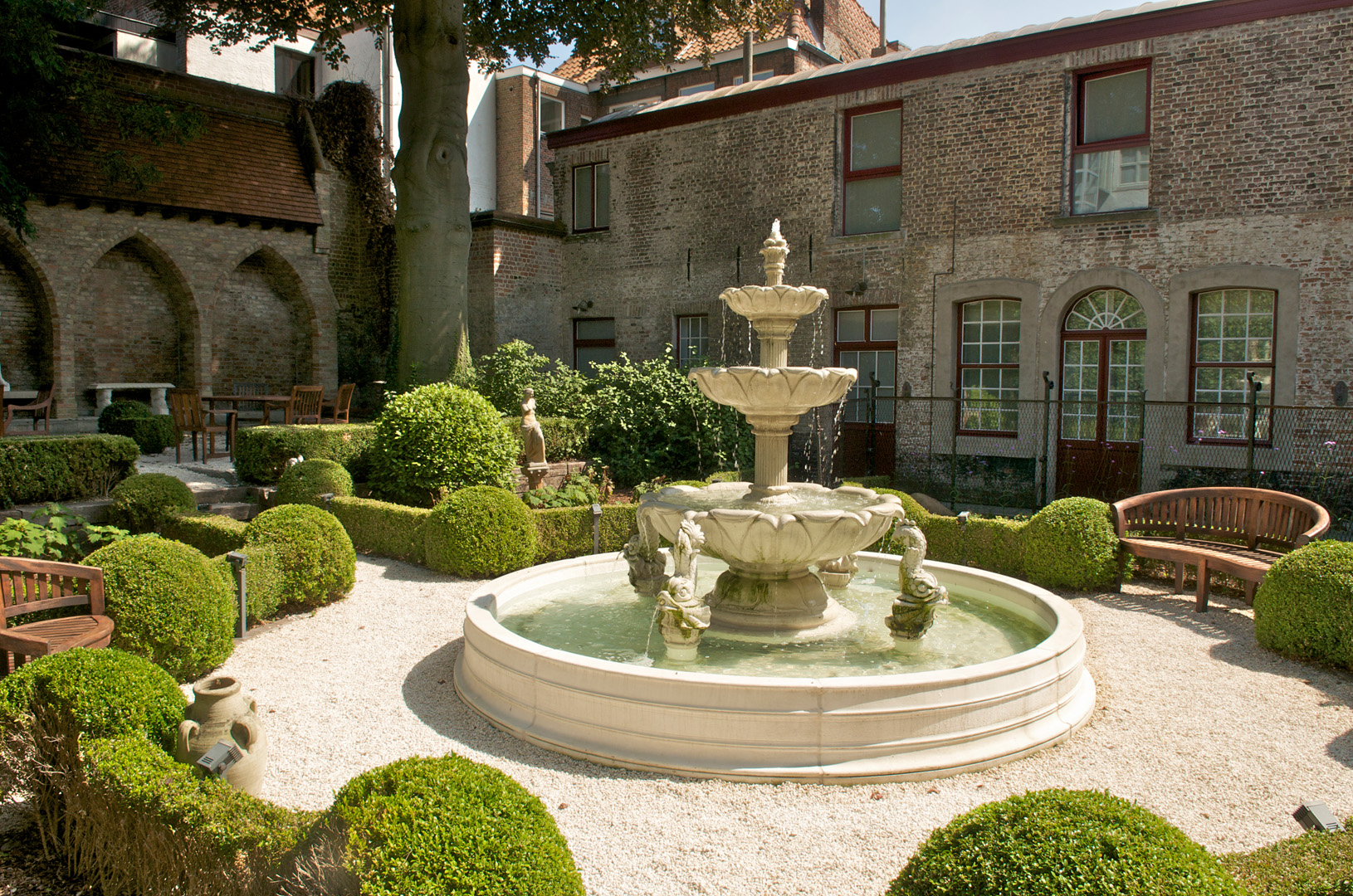 WHERE TO
STAY
WHERE TO
STAY
I stayed at a uniquely lovely new
hotel built on solid old bones. Opened only last
year and owned and run with grace by Dimitri Thirion
and Betty Devos, Hotel
Jan Brito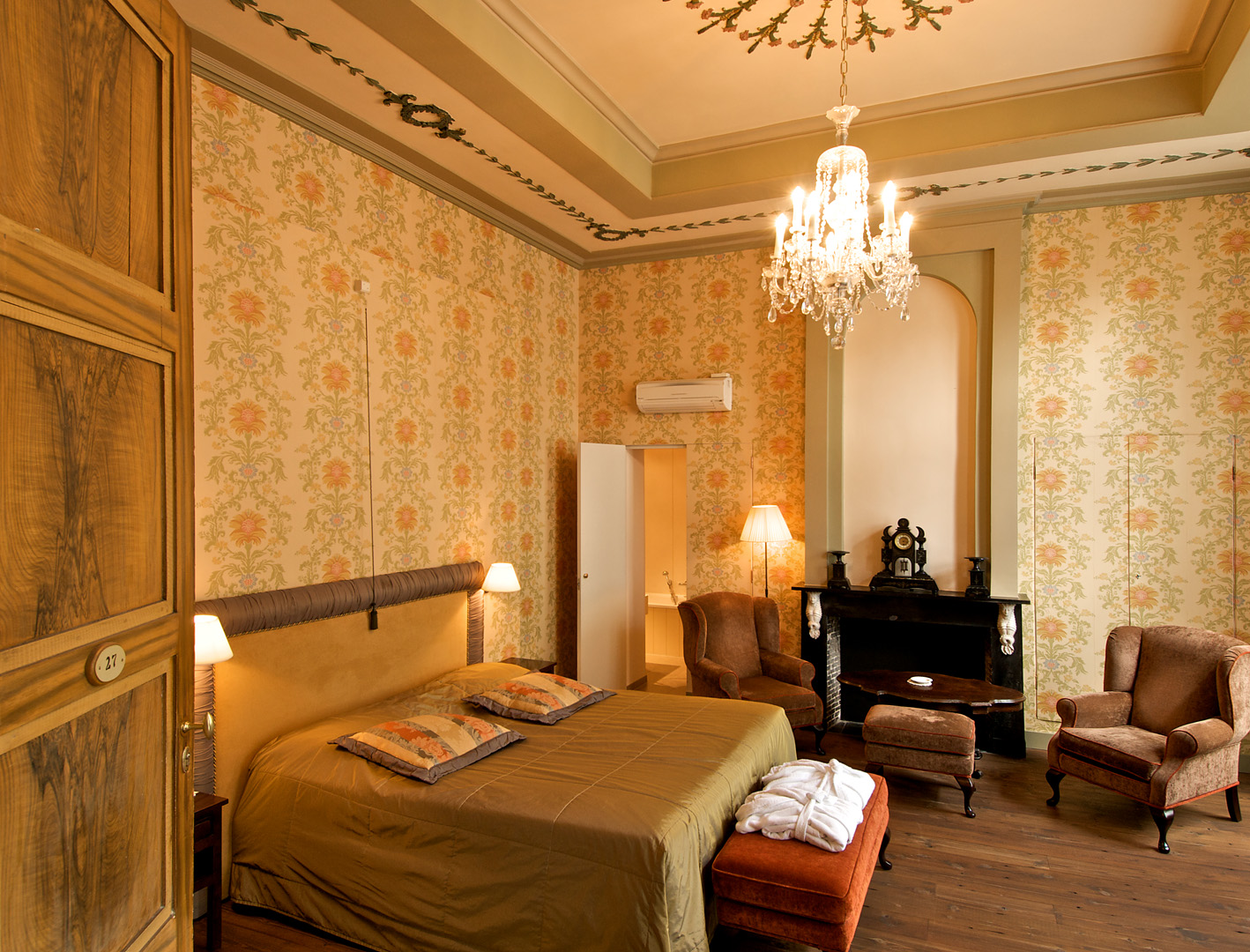 (Freren
Fenteinstraat 1; 32-50-33-0601) was once a
16th century manor house now composed of 37
individual guest rooms with very fine bathrooms and
a staff that could not possibly be more friendly or
knowledgeable. It’s a very romantic spot centered
around a garden, with a sunny breakfast room,
elegant reading room, and its location just right
around the corner from the Fish Market and a few
more steps to the Church of Our Lady and Grand
Market makes it an ideal spot that is remarkably
quiet for being so much in the center of things.
(Freren
Fenteinstraat 1; 32-50-33-0601) was once a
16th century manor house now composed of 37
individual guest rooms with very fine bathrooms and
a staff that could not possibly be more friendly or
knowledgeable. It’s a very romantic spot centered
around a garden, with a sunny breakfast room,
elegant reading room, and its location just right
around the corner from the Fish Market and a few
more steps to the Church of Our Lady and Grand
Market makes it an ideal spot that is remarkably
quiet for being so much in the center of things.
❖❖❖
By John Mariani
Photos by Jason Greenspan
553
Manhattan
Avenue
(at 123rd Street)
212-729-1850
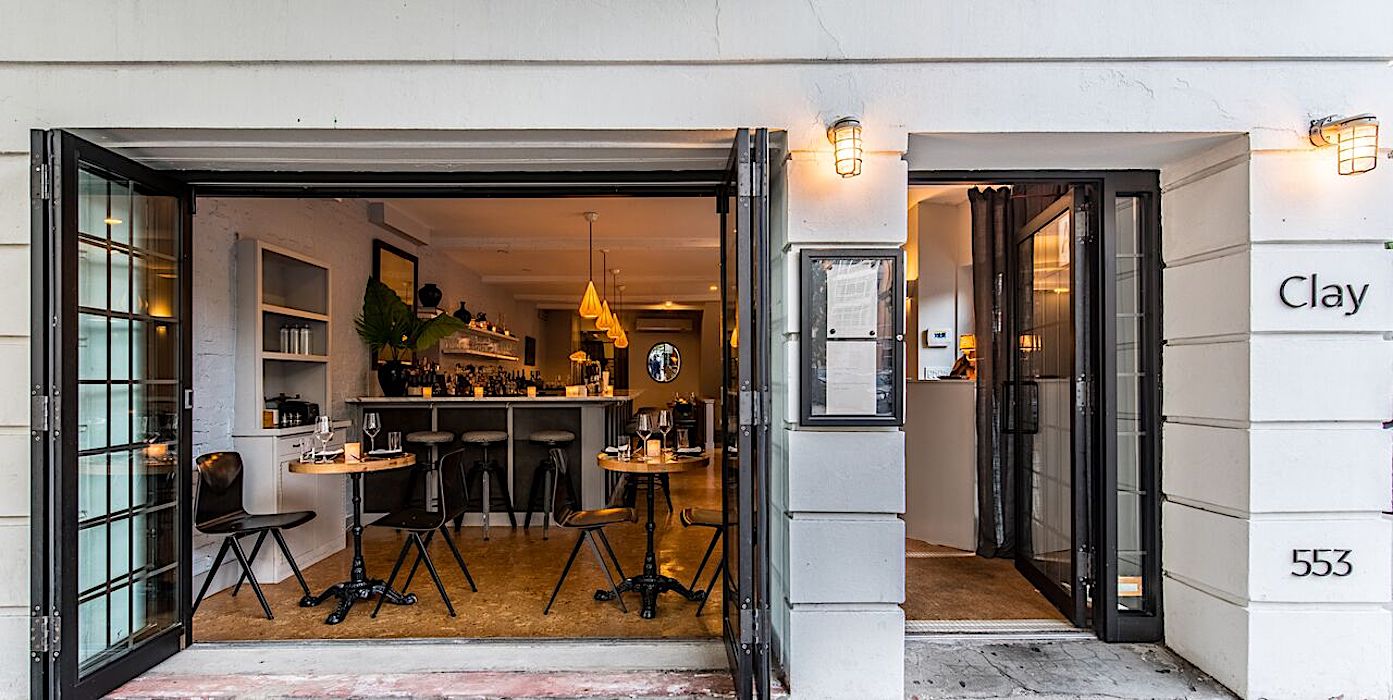
The
gastronomic progress in Harlem has little of the
fevered pitch of
Brooklyn, and it’s all the better for
that. Harlem’s best new restaurants continue to
serve their neighborhood, rather than cater to
those who would never set foot on the A train
unless propelled to do so by the food media.
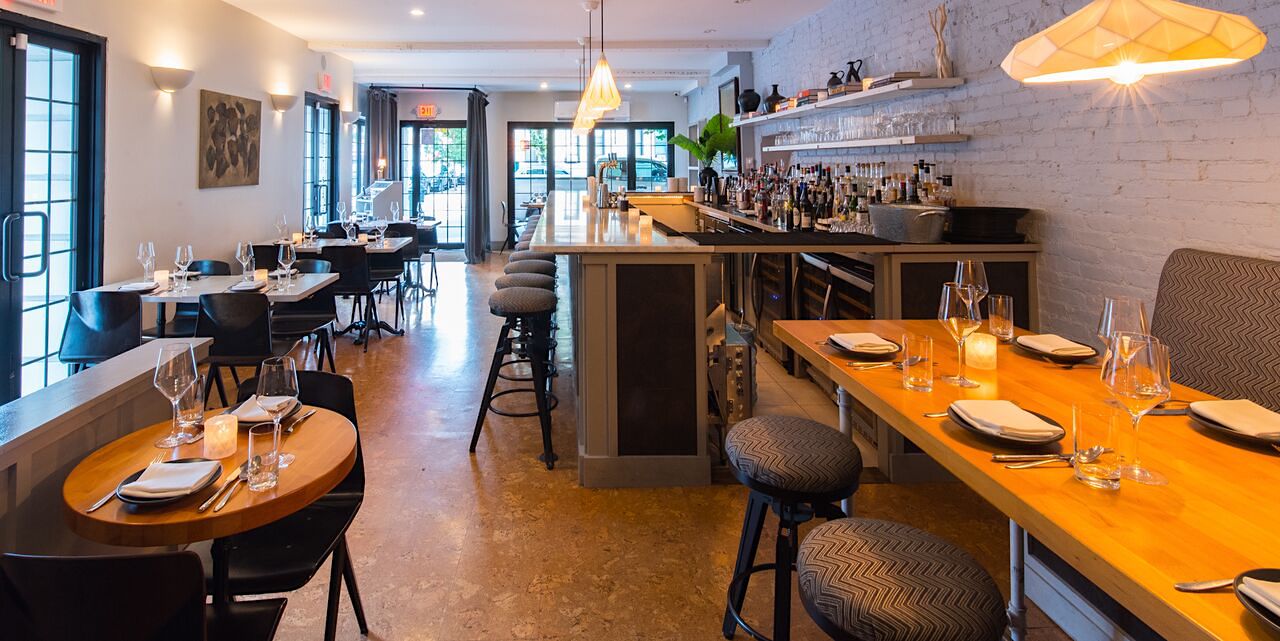 Clay, now
open for a year, joins a slew of alluring
restaurants like Vinateria, Maison Harlem, Zoma
and others that may lack the hype but enjoy brisk
business via word-of-mouth.
Clay, now
open for a year, joins a slew of alluring
restaurants like Vinateria, Maison Harlem, Zoma
and others that may lack the hype but enjoy brisk
business via word-of-mouth.
Sometimes you can tell
immediately when a chef is cooking exactly what he
wants, and every dish on Clay’s menu shows the
taste and commitment of Chef Gustavo Lopez, whose
work I previously enjoyed at Vinateria, DBGB and
Lupa. Wine Director Gabriela Davogustto and Bar Director Andrea Needell Matteliano also
are on their games, providing both a wine list of
unusual bottlings at all prices and a cocktail
list of novelties.
The restaurant is set on the
corner of Manhattan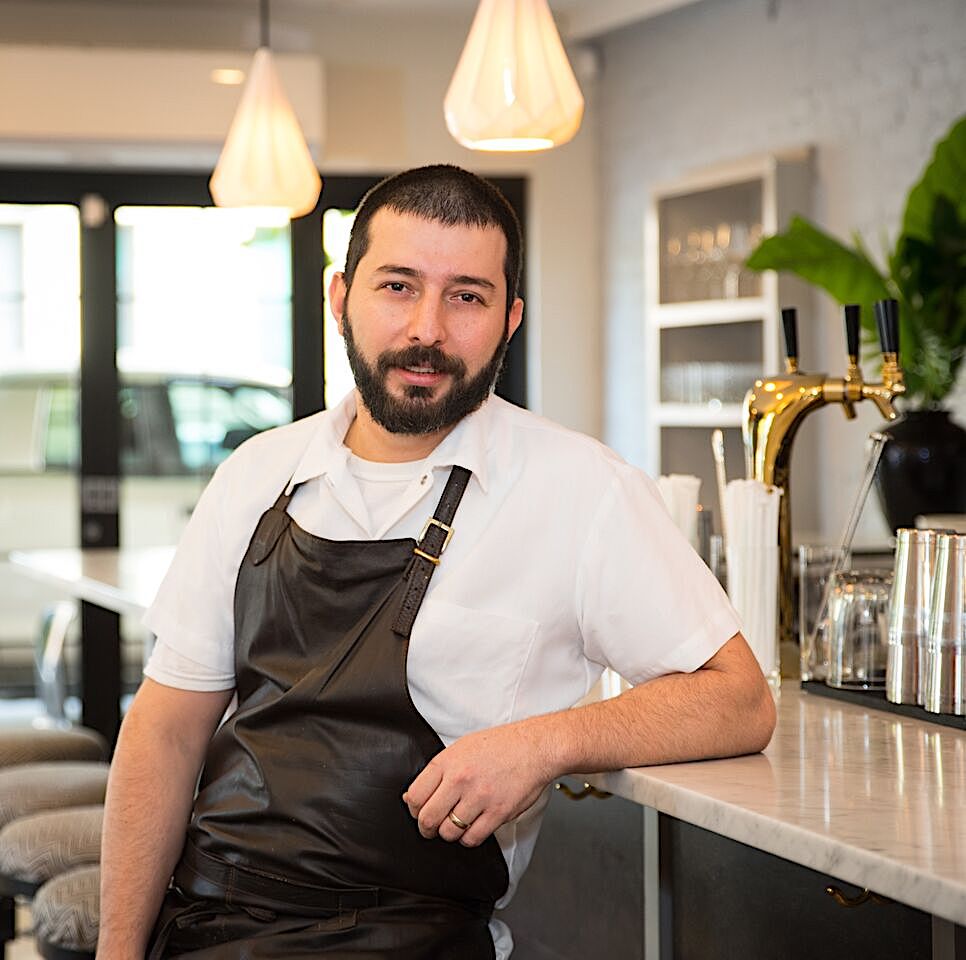 Avenue and 123rd Street, which is
fast being restored from those derelict days of
the recent past. Clay’s white façade and interior
lights boost the buoyant spirit on the block. Inside,
with a long, white marble bar to the left and
tables to the right, the room, with a downstairs
adjunct dining room, is done in off-white, with a
muted
gray
painting of
fragmented
clay pottery
on one wall and rough-hewn white
stone
on another, all set atop terracotta
flooring. The
sound level is mercifully
civilized, with an appealing playlist by music
director Javier Peral.
Avenue and 123rd Street, which is
fast being restored from those derelict days of
the recent past. Clay’s white façade and interior
lights boost the buoyant spirit on the block. Inside,
with a long, white marble bar to the left and
tables to the right, the room, with a downstairs
adjunct dining room, is done in off-white, with a
muted
gray
painting of
fragmented
clay pottery
on one wall and rough-hewn white
stone
on another, all set atop terracotta
flooring. The
sound level is mercifully
civilized, with an appealing playlist by music
director Javier Peral.
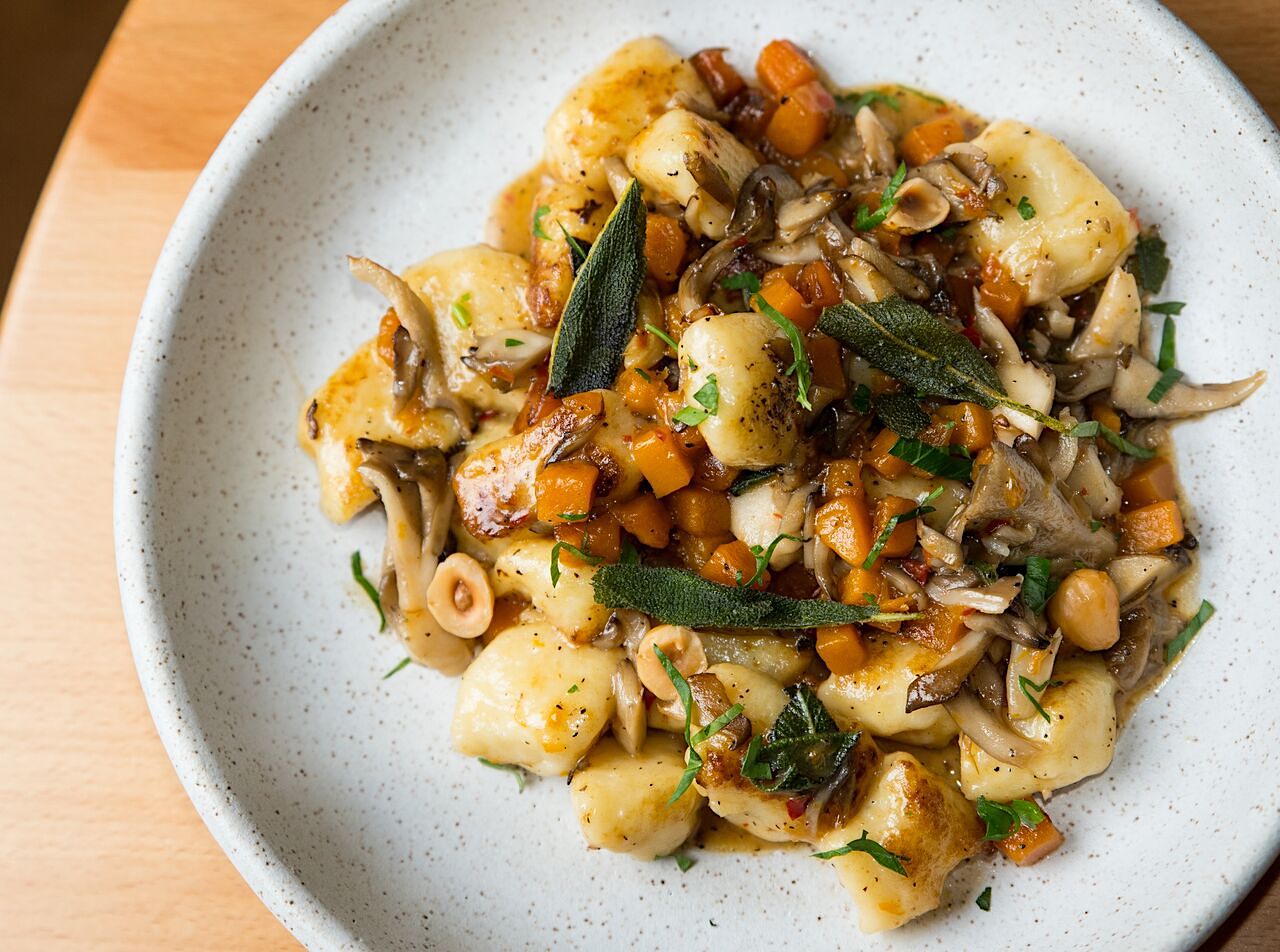 Clay’s
menu is hard to choose from because just about
everything sounds so delicious, even a bowl of
roasted nuts, fried sage and buckwheat ($8) to
nibble on. Just
right for summer is the plate of heirloom
tomatoes, watermelon, artisanal cheese and chewy
pumpkin seeds ($16), as is a bright and colorful
dish of raw fluke in a tangy bath. As a
surprise appetizer, pork belly with apple,
fermented cabbage, mustard seed, lardo
and kombu
seaweed glaze ($19) showed how every dish Lopez
conceives gets a sparking acidic edge that
brightens every ingredient and serves as a foil to
the fat.
Clay’s
menu is hard to choose from because just about
everything sounds so delicious, even a bowl of
roasted nuts, fried sage and buckwheat ($8) to
nibble on. Just
right for summer is the plate of heirloom
tomatoes, watermelon, artisanal cheese and chewy
pumpkin seeds ($16), as is a bright and colorful
dish of raw fluke in a tangy bath. As a
surprise appetizer, pork belly with apple,
fermented cabbage, mustard seed, lardo
and kombu
seaweed glaze ($19) showed how every dish Lopez
conceives gets a sparking acidic edge that
brightens every ingredient and serves as a foil to
the fat.
There are four pastas on the
menu, not as throwaway dishes but as well-wrought
hearty main courses that include light, perfectly
rendered potato gnocchi (left) with 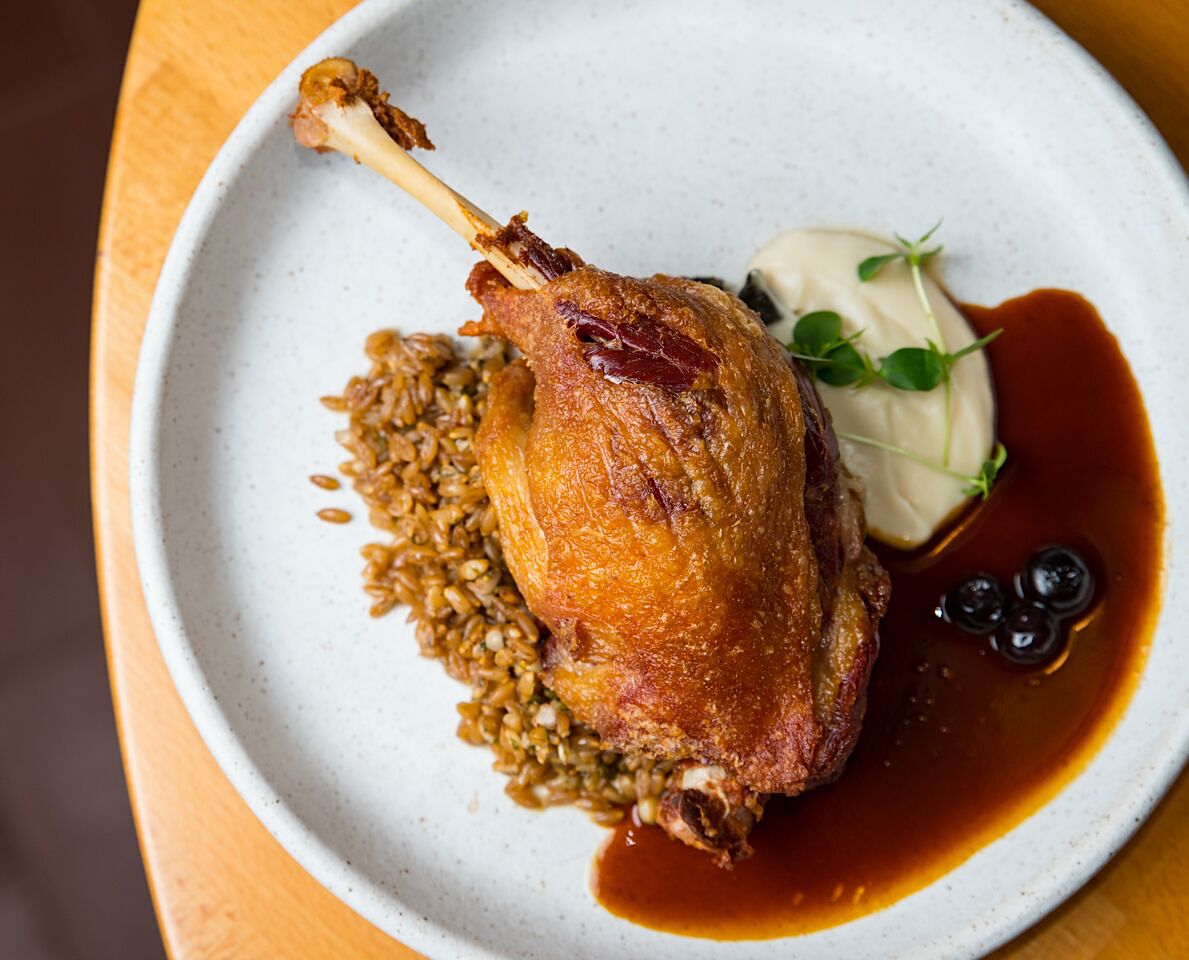 fava beans, peas, oyster
mushroom, hazelnuts, sage and pickled Fresno chile
($22) and a hefty bowl of wide paccheri
macaroni in a long-simmered short rib ragù with a
generous dousing of Parmigiano ($26).
fava beans, peas, oyster
mushroom, hazelnuts, sage and pickled Fresno chile
($22) and a hefty bowl of wide paccheri
macaroni in a long-simmered short rib ragù with a
generous dousing of Parmigiano ($26).
Tender lamb shank ($30) was a
special one night, proving that there really is no
such thing as a warm weather versus cold weather
dish, and Lopez is expert at making a duck leg
confit (right),
luxuriously rich but not greasy in the least, with
celeriac, smoked farro, collard greens and—here
again the acid note—a gastrique ($32). The
flesh of black bass was a little soft from a
moment too long in the heat but came both piping
hot and well enhanced by shiitakes, corn, roasted
peppers and a marvelous brown butter ($32).
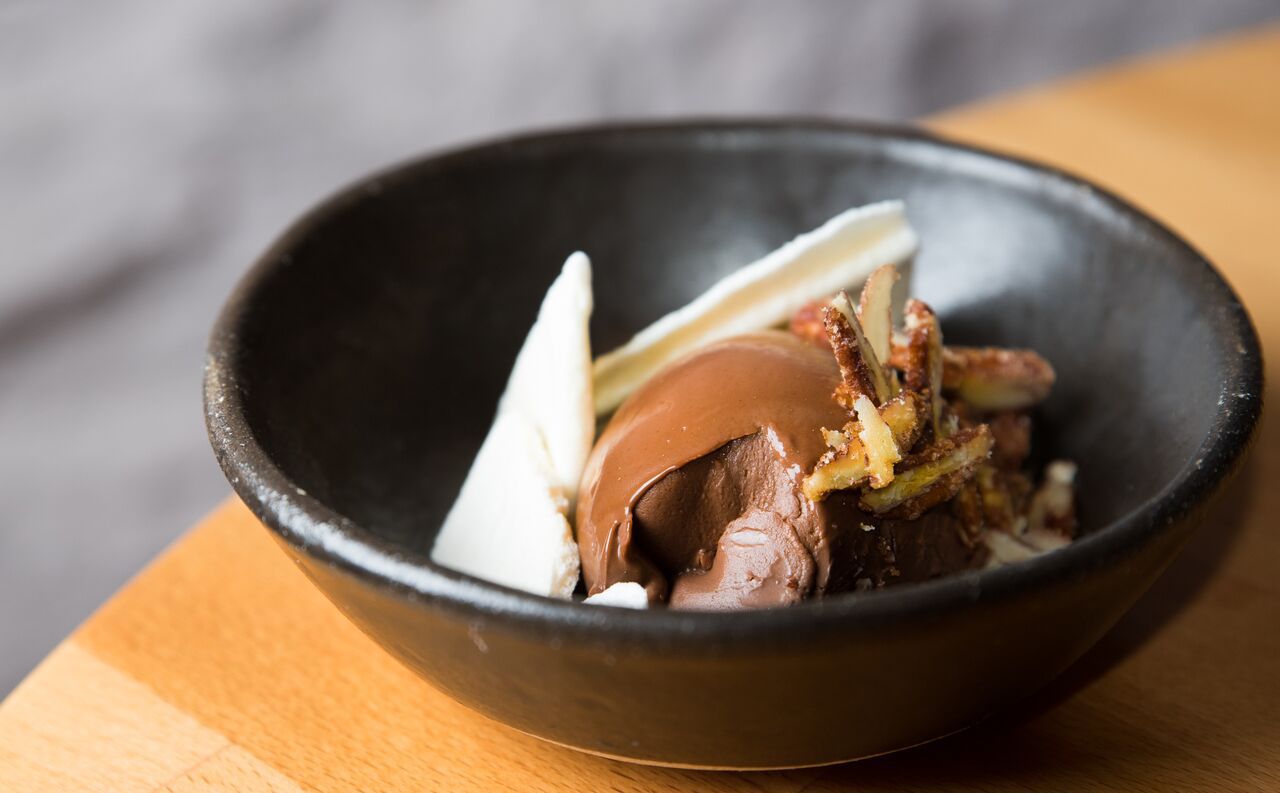 The
mini-donuts with lemon verbena for dessert are a
guilty pleasure, and the chocolate budino
pudding with spiced pecans and meringue chips (left) is as
sophisticated yet simple dessert as you could wish
for. Yogurt panna
cotta was, however, bland. Go ahead and
enjoy one of the seven dessert wines offered.
The
mini-donuts with lemon verbena for dessert are a
guilty pleasure, and the chocolate budino
pudding with spiced pecans and meringue chips (left) is as
sophisticated yet simple dessert as you could wish
for. Yogurt panna
cotta was, however, bland. Go ahead and
enjoy one of the seven dessert wines offered.
As with any true neighborhood
restaurant, Clay is a place to drop into for a
cocktail and bite at the bar, have a light repast
of appetizers or have a full meal that will never
be quite the same from week to week. The crowd is
composed of locals, some just moved to Harlem,
others from up the hill at Columbia University.
There is none of that mad rush or lines of
beseeching foodies bunched up at the hostess
station. At
least for now, and I hope it stays just that way.
Open
for dinner Tues.-Thurs.; Sunday for brunch.
By John Mariani
HEALTHY VINES TO TUSCANY,
THEN INNOVATION OF ITS OWN
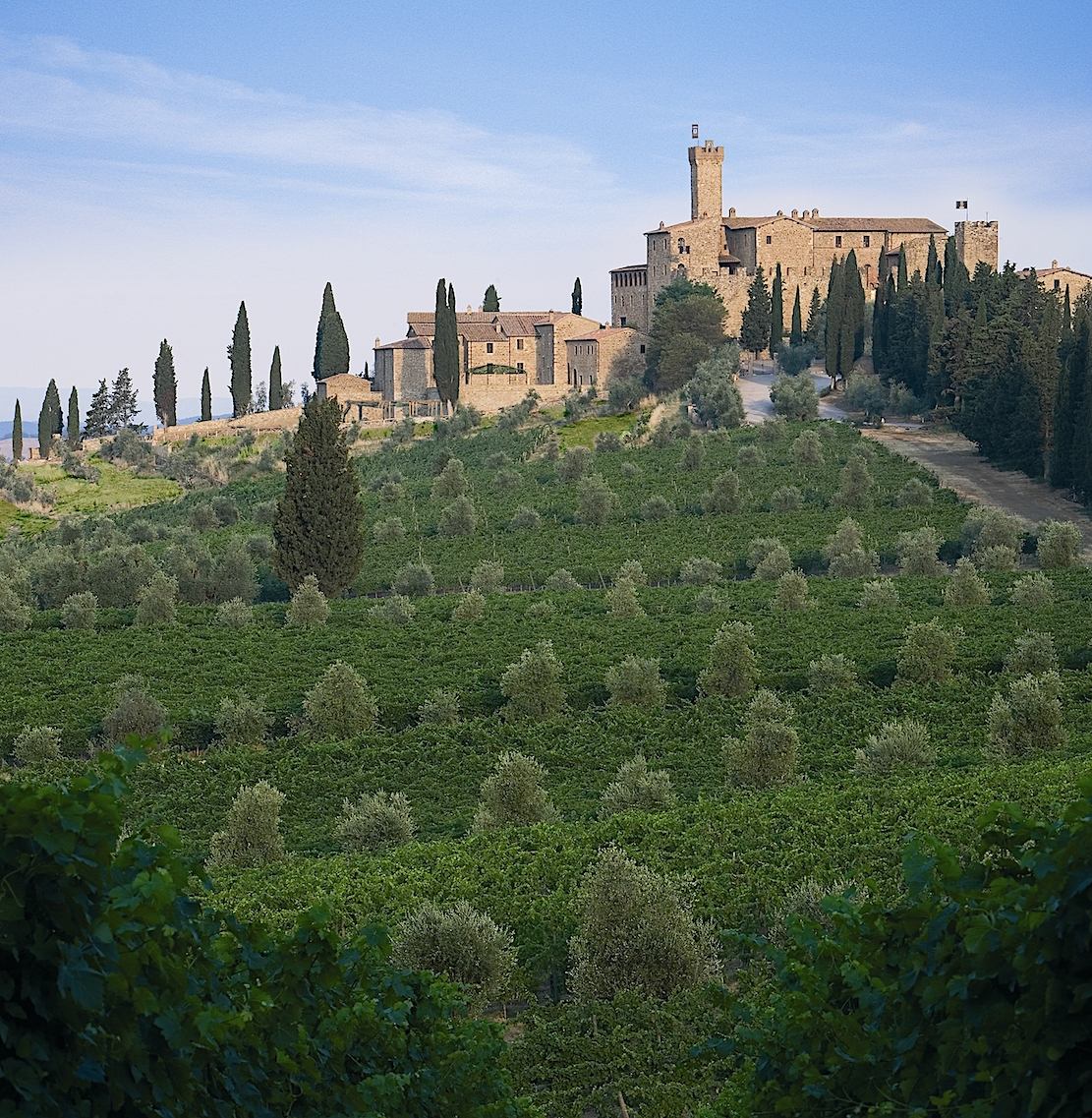
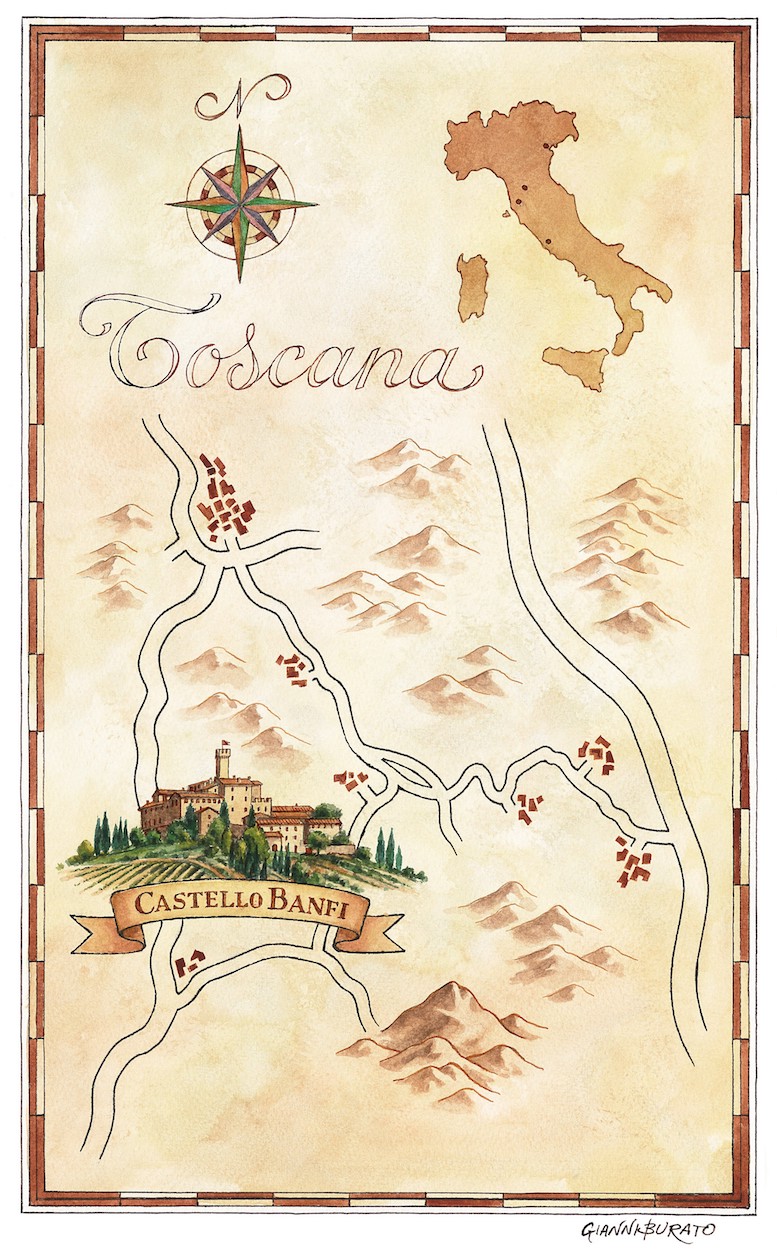 So I’ve
gotten to know their wines quite well,
especially those from Tuscany, where Banfi began
developing vineyards back in
the late 1970s and where they invested in
extensive ampelographic
research over a ten-year period to come up with
the 15 best, healthiest clones
out of 650 of Sangiovese grapes, information
they shared freely with their
competitors. Before that, long-time producers
didn’t really know much about
their vineyards’ constitution or their
So I’ve
gotten to know their wines quite well,
especially those from Tuscany, where Banfi began
developing vineyards back in
the late 1970s and where they invested in
extensive ampelographic
research over a ten-year period to come up with
the 15 best, healthiest clones
out of 650 of Sangiovese grapes, information
they shared freely with their
competitors. Before that, long-time producers
didn’t really know much about
their vineyards’ constitution or their 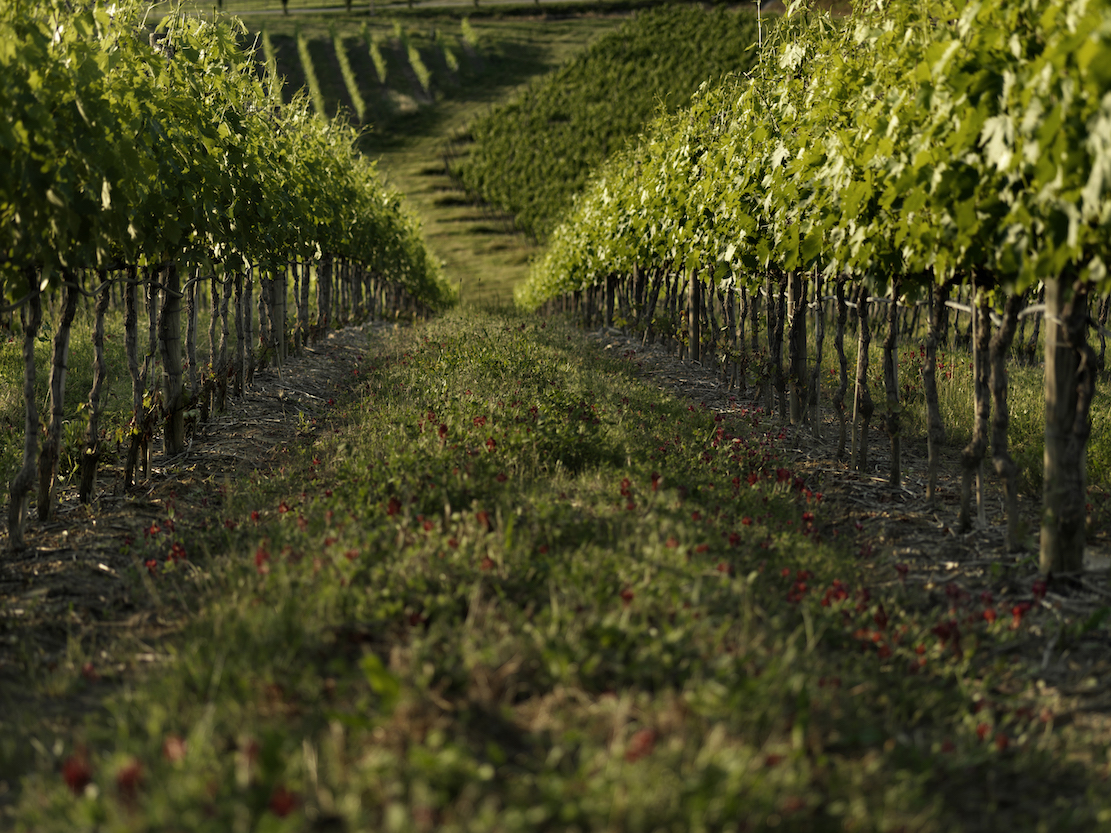 vines’
ancestry.
vines’
ancestry.That was also at a time when the region’s Brunello di Montalcino began gathering renown as one of Italy’s finest red wines, then being produced by a handful of estates like Biondi Santi and Fattoria dei Barbi to be long-lived wines that could take decades to fully mature. Back in 1975 only 800,000 bottles of Brunello were produced by 25 estates; by 1995 more than 3.5 million bottles were made by 120 estates; three years later there were 180, producing 7 million bottles annually, with 60 percent exported, and 25 percent of total production going to the U.S. market; Only about 20 percent is consumed locally around Montalcino and in Tuscany. Banfi is by far the largest investor, where its estate is called Castello Banfi.
The current vintage of Banfi’s Brunello di Montalcino ($80) was from a cool, rainy year, so the wine, while unfiltered, is lighter in body (alcohol is 13.5%) and therefore easier to drink earlier. A couple more years in bottle will surely add to its allure, but for now this is a solidly knit, velvety Brunello at a very reasonable price, with several in the same or lesser league going for $15-$20 more.
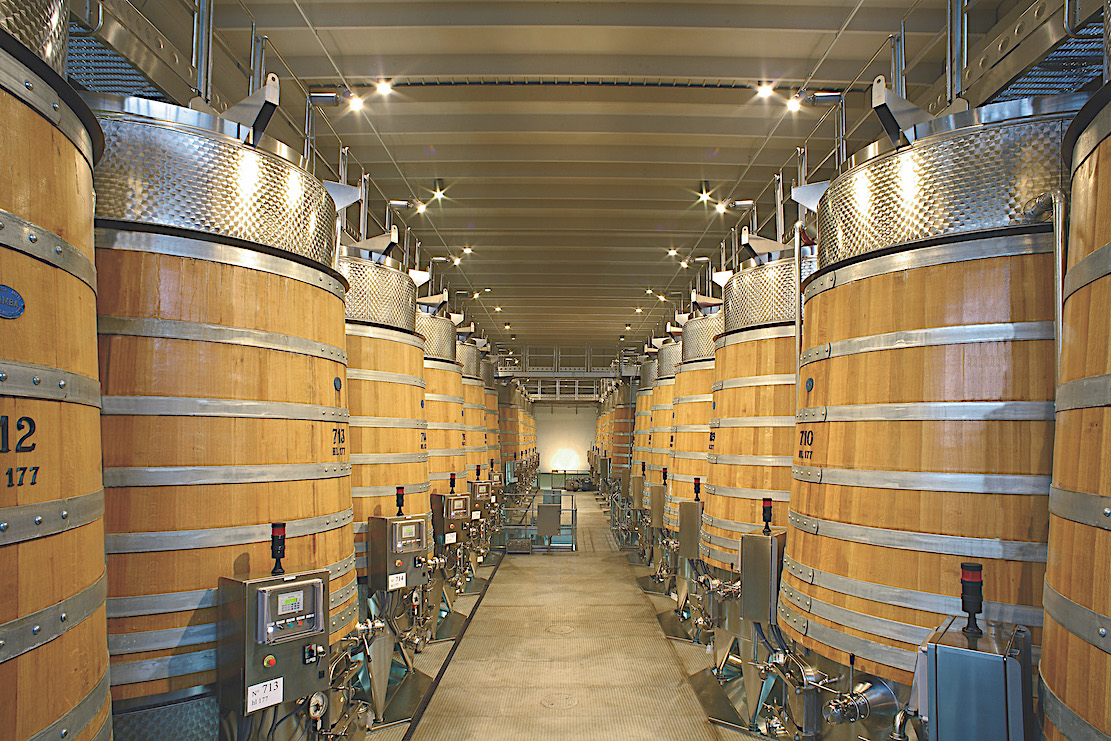 Rosso di Montalcino
shares the Sangiovese grape,
but is a wine made for easy drinking while still
retaining the varietal
character. Banfi’s 2016 vintage ($27) spent only
10-12 months in oak, and I
find it a remarkably refined example in the face
of so many of what I call
overpriced “restaurant rosso di Montalcinos” with
little or no nuances of fruit
layers.
Rosso di Montalcino
shares the Sangiovese grape,
but is a wine made for easy drinking while still
retaining the varietal
character. Banfi’s 2016 vintage ($27) spent only
10-12 months in oak, and I
find it a remarkably refined example in the face
of so many of what I call
overpriced “restaurant rosso di Montalcinos” with
little or no nuances of fruit
layers.Castello Banfi makes a few wines unique to the estate, with Cum Laude 2014 ($40)—the name, as in graduating honors, means “with praise”—being an I.G.T. appellation, meaning it is typical of the region but made accordingly to the estate’s own blend. In this case, at 14.4% alcohol, Sangiovese makes up only a component of a wine whose principal grape is Cabernet Sauvignon, along with Merlot and
 Syrah, a unusual blend
for Tuscany
that results in a very fruity, very velvety wine
adaptable to an array of
foods, including pastas with tomato sauce or
mushrooms.
Syrah, a unusual blend
for Tuscany
that results in a very fruity, very velvety wine
adaptable to an array of
foods, including pastas with tomato sauce or
mushrooms.SummuS 2014 ($80) is made from grapes in the southern part of Montalcino, where stony, calcium-rich soil gives the wine its abundant mineral qualities. Cabernet Sauvignon (35%), Syrah (25%) and Sangiovese (405%)--the blend differs in percentage each year--are first vinified separately, then transferred to French oak barriques, also separately, for 12-14 months. Only then are they blended and stored away for another 10-12 months and, finally, six months of bottle age. The result is a wine that explains its name—“the greatest”—within the Banfi constellation, for it is indeed a very complex wine. This one I really do want to keep in my cellar for another two or three years before it reveals all of its finesse, its tannins soften and the fruit and acid come into ideal balance.
 Banfi has since the
2012 vintage made a wine
named Aska,
with the current vintage 2015, which is made in
the Bolgheri D.O.C.
region noted for its so-called “Super Tuscans.”
At $34, this is a bottle whose
label reads only “red wine” and whose name is
Etruscan for a “container” used
not only to store wine and perfume but “to
protect hopes,
dreams, happiness and joy, entrusted to Etruscan
gods Cuatha and Sernia (Sun
and Moon),” pictured on the label. There is not a
drop of Sangiovese in this
blend of Cabernet Sauvignon and a little Cabernet
Franc drawn from soils rich
in limestone and clay—the latter not always ideal
for Sangiovese.
Banfi has since the
2012 vintage made a wine
named Aska,
with the current vintage 2015, which is made in
the Bolgheri D.O.C.
region noted for its so-called “Super Tuscans.”
At $34, this is a bottle whose
label reads only “red wine” and whose name is
Etruscan for a “container” used
not only to store wine and perfume but “to
protect hopes,
dreams, happiness and joy, entrusted to Etruscan
gods Cuatha and Sernia (Sun
and Moon),” pictured on the label. There is not a
drop of Sangiovese in this
blend of Cabernet Sauvignon and a little Cabernet
Franc drawn from soils rich
in limestone and clay—the latter not always ideal
for Sangiovese.At 14% alcohol it is a medium-bodied wine aged for only ten months, so it has a pretty freshness in the bouquet and acid that gives it brightness. It’s a good summer red for chicken on the grill, veal chops and cheese like pecorino, Parmigiano and robiola.
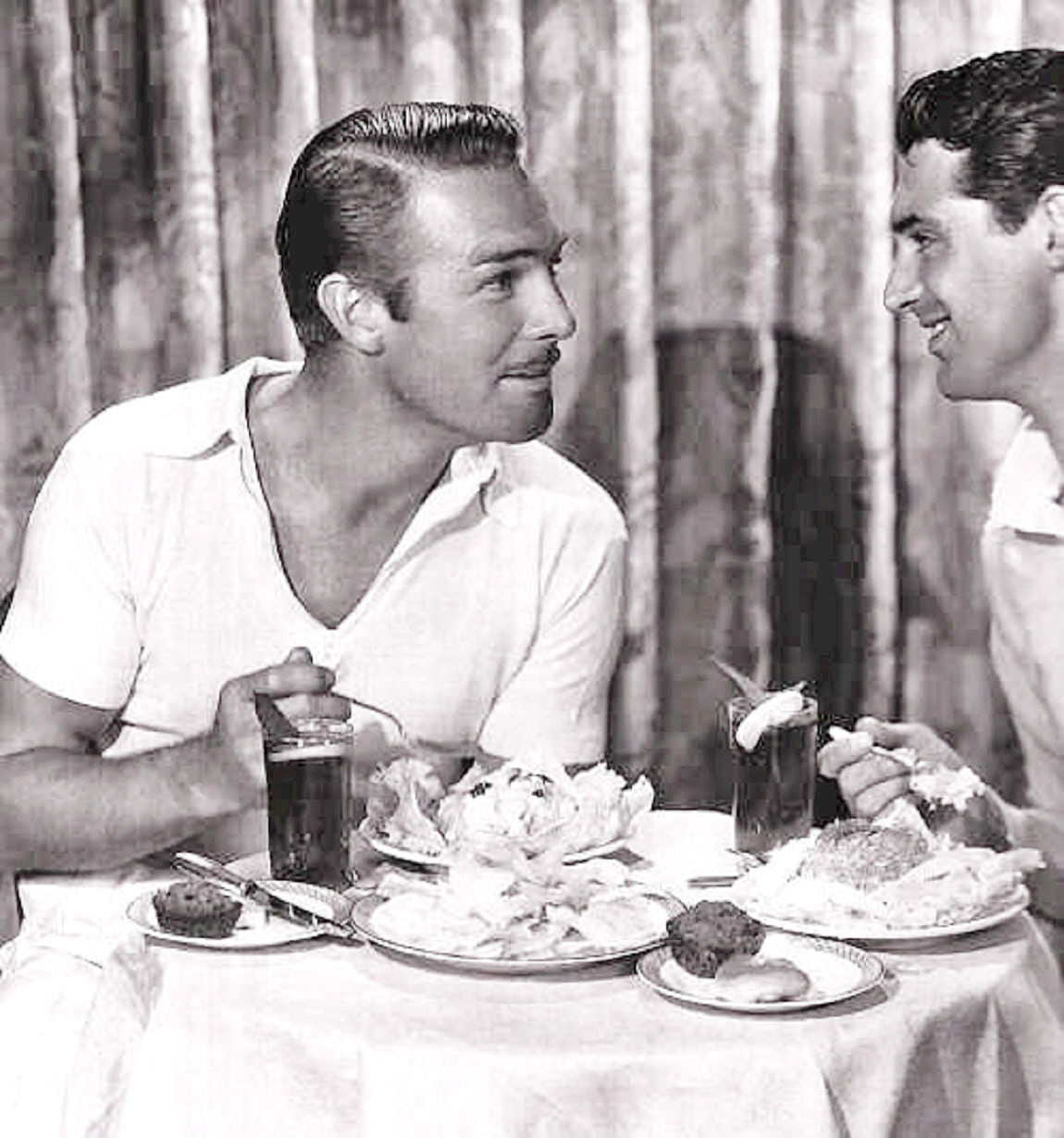
DINNER CONVERSATIONS WE
REALLY DON'T CARE TO JOIN
"There’s no such thing as
queer food — but once you start looking, it’s
everywhere. There’s
nothing explicitly queer about the dinner series hosted
by French chef Laurent Quenioux on a sleepy side street
in the Highland Park neighborhood of Los Angeles.
. . . And yet, as a gay man-ish person, I have always
found these dinners to be an undeniably queer space,
even if I couldn’t offer the exact reason why. Is it the
fact that Quenioux is gay? That’s an important starting
point, but plenty of events and restaurants run by gay
chefs are not necessarily queer. Is it the decadent
plates, each served by the chef with a pinch of
backstory or a dirty little joke? Or the fact that you
know you’re in when Quenioux sits down to sip a glass of
wine, and whispers which cheese he smuggled over from
Langres, the taste of which reminds him of an old lover?
Or is it Quenioux’s expert social engineering? If the
guest list is too heavy on newcomers and polite
acquaintances, he will invite flamboyant close friends
and previous attendees to shake things up. It’s not any one of these things, but it is
all of them, a merging of ambition, sensuality, and
social enchantment which is undeniably, ineffably
queer."--Kyle Ftizpatrick, "Queer Food Is Hiding in
Plain Sight," Eater.com
(6/28)
THE ROYAL STIFF UPPER LIP STAYED SHUT
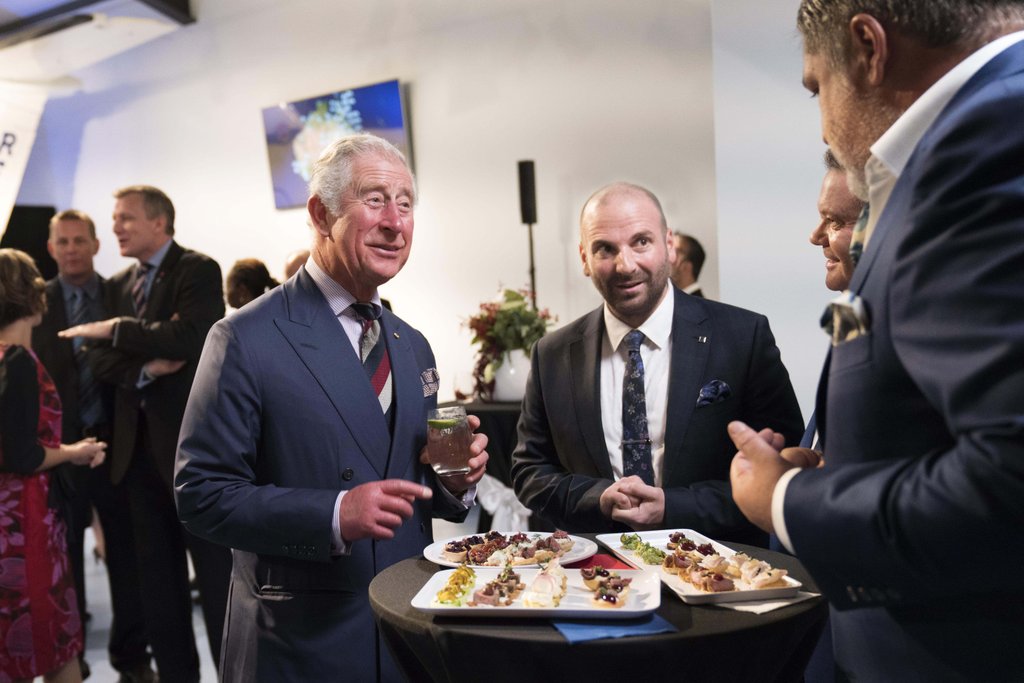
On the Australian version of MasterChef Prince
Charles awkwardly didn’t eat a bite that was served to
him during
his guest appearance, where the contestants were
asked to use local Australian ingredients, which
included wallaby tartare topped
with green ants, and goat's cheese mousse with
bush spices. His wife Camilla added,
“I
hate to say this, but no garlic. Garlic is a no-no,”
❖❖❖
Wine
Column Sponsored by Banfi Vintners
SANGIOVESE
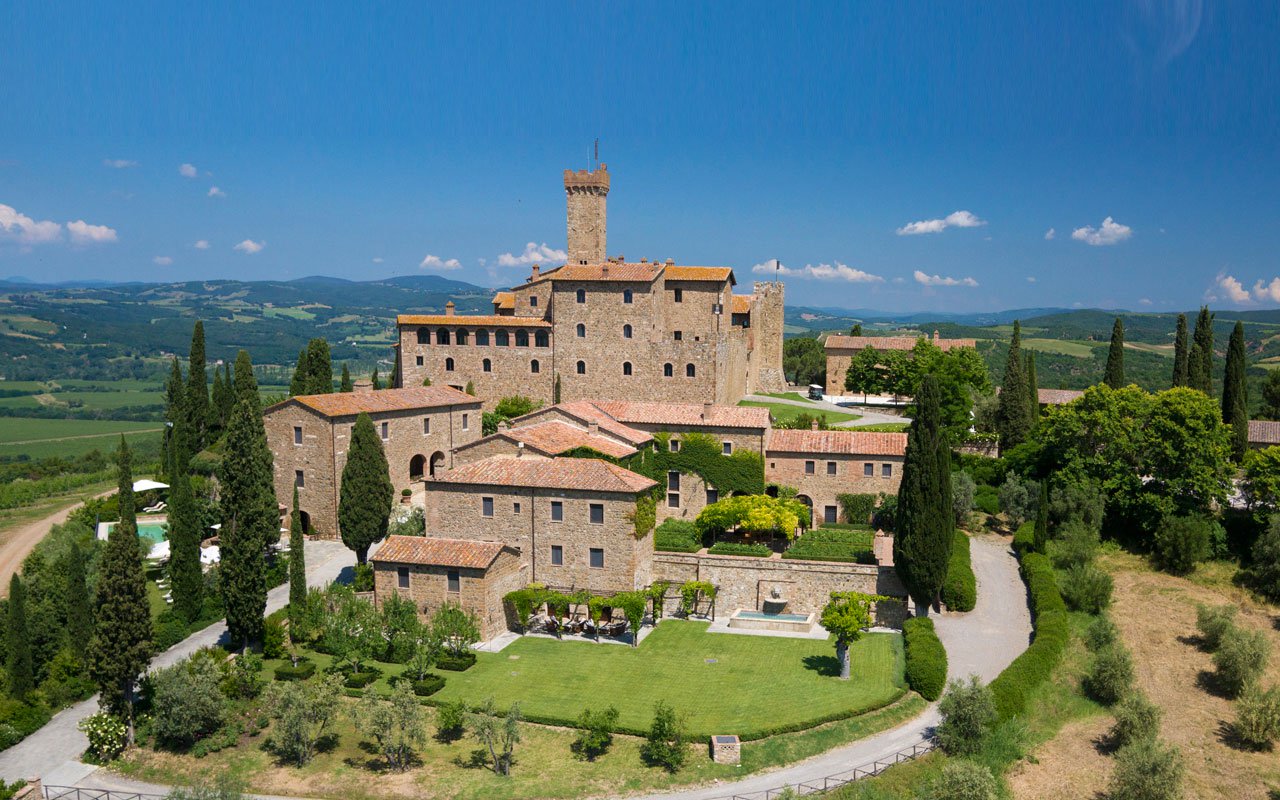 Wine is a joy year-round but
in cooler weather one
grape varietal has really taken center stage in
my daily activities – that most Italian of
grapes, Sangiovese, and its ultimate expression
– Brunello di Montalcino.
Wine is a joy year-round but
in cooler weather one
grape varietal has really taken center stage in
my daily activities – that most Italian of
grapes, Sangiovese, and its ultimate expression
– Brunello di Montalcino.
From mid-September through mid-October,
the Sangiovese grown for our various styles of red
wines are be harvested, culminating with the top
selection for Brunello di Montalcino.
Second, cooler weather here means
it is time to start enjoying more red wines and
especially Sangiovese based wines. That
includes Banfi’s cru of Brunello, Poggio alle Mura,
literally the cream of the crop of our Sangiovese
vineyards. Alongside our Poggio alle Mura Brunello di
Montalcino, this year we introduced two more wines
from the cru Poggio alle Mura – a Rosso di Montalcino
and a Riserva of Brunello. Rosso is sort of like the
younger brother of Brunello, also made from 100%
Sangiovese grapes but usually a selection from younger
vines and the wine is aged only two years compared to
the four required for Brunello. The
Riserva, on the other hand, is an even more selective
harvest of Sangiovese, and ages for an additional year
before release.
What is so special about this cru
Poggio alle Mura?
Well, it is the result our over 30 years of
ongoing research at my family’s vineyard estate,
Castello Banfi.
When we first began planting our vines there in
the late 1970s studies from the University of Bordeaux
indicated which strains of many varietals we should
plant, based on the soil type and microclimate of each
vineyard. But
when it came to the region’s native Sangiovese, there
was only local lore, no scientific research. So we took
it upon ourselves to figure out this vine, and set off
on three decades of incredibly detailed research.
We started
with 600 apparent variations on Sangiovese, because it
is so susceptible to variations in weather and soil,
and narrowed that down to 160 truly genetically
different clones.
We planted a vineyard with two rows of each
type, made wine from each of them, and charted the
differences – remember, you only get one chance a year
to make wine, so this took time.
It took about ten years to get some
concrete results, though we continue to experiment
today and always will – you never stop learning in
science and nature!
Once we determined which were the best,
complementary clones that could be planted together to
make the best Brunello, we chose to plant them in what
we determined to be the optimal vineyard sites. Coincidentally,
the best soils and climate conditions are in the
slopes surrounding the medieval fortress today known
as Castello Banfi, known since Etruscan times as
Poggio alle Mura – the walled hilltop. Hence the
name of our most special “cru” of Brunello,
representing a synthesis between tradition and
innovation.
Though the focus of this study was
our Brunello, all of our Sangiovese-based wines,
including the super Tuscans SummuS, Cum Laude, and
Centine, benefitted from this work. And that’s
the third reason for celebrating Sangiovese this
month, for the range of wonderful reds that usher us
into autumn! One
wine in particular was inspired by our research – the
BelnerO, a Sangiovese dominant blend with what I like
to call a kiss of Cabernet and a whisper of Merlot. We grow the
grapes a little differently for BelnerO than for
Brunello, make the wine with less oak aging and
released it earlier from the winery, providing a
counterpoint to Brunello and a lovely terroir-driven
wine in its own right.
If you
know Italians, you know that by nature we are
multi-faceted, varying in mood, and always passionate. As a
nation, we span from the hot sunny beaches of Sicily
near the African coast to the rugged mountains and
Alpine ski slopes of Trentino-Alto Adige in the north. Sangiovese
is grown in almost all of Italy’s regions and reflects
the unique nature of each; it is most famous
(rightfully so) in Tuscany, yet even there it reflects
the nuances of each hilltop, valley and subzone. It has
something a little different to say in Brunello than
Chianti, Morellino than Vino Nobile di Montepulciano,
Rosso di Montalcino than Super Tuscan blends.
Here is a smattering of
Sangiovese-based wines that you may wish to get to
know better, reflecting a spectrum that appeals to
every occasion, every taste, and every budget. We can
assure you that the conversation will never become
boring. 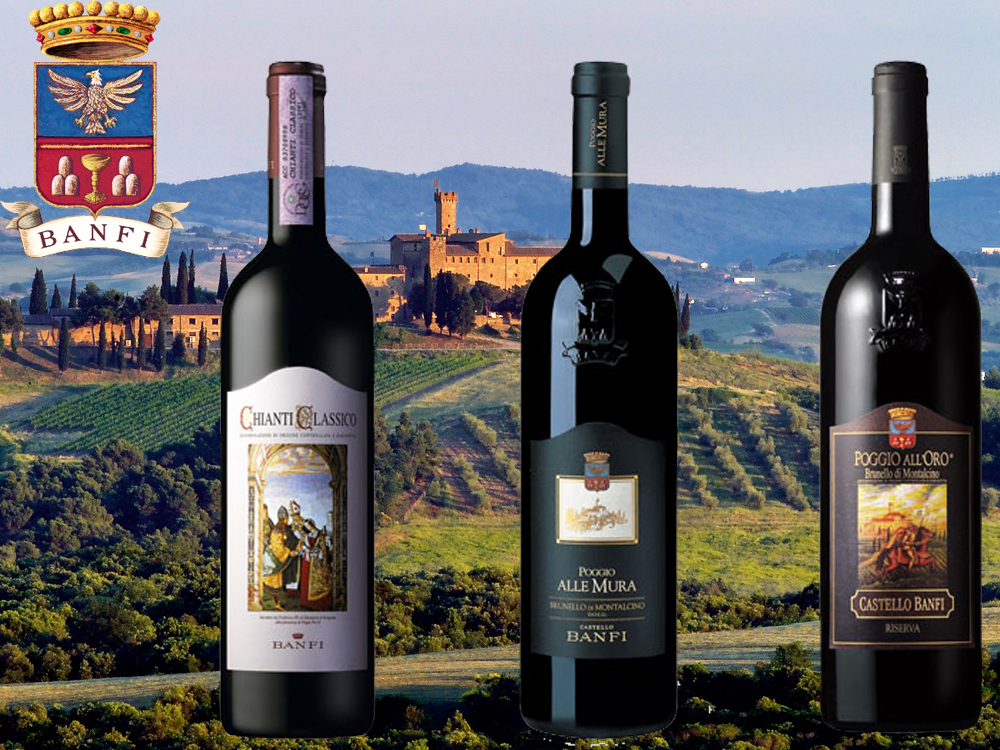
Recommendations for Celebrating
Sangiovese
BelnerO Proprietor’s Reserve Sangiovese
– A refined
cuvée of noble red grapes perfected by our pioneering
clonal research. This dark beauty, BelnerO, is
produced at our innovative winery, chosen 11
consecutive years as Italy’s Premier Vineyard Estate.
Fermented in our patented temperature controlled
French oak and aged approximately 2 additional years.
Unfiltered, and Nitrogen bottled to minimize sulfites.
Castello Banfi Brunello di Montalcino –
Rich, round, velvety and intensely
aromatic, with flavor hints of licorice, cherry, and
spices. Brunello di Montalcino possesses an intense
ruby-red color, and a depth, complexity and opulence
that is softened by an elegant, lingering aftertaste.
Unfiltered after 1998 vintage.
Castello Banfi Rosso di Montalcino – Brunello's "younger brother," produced
from select Sangiovese grapes and aged in barrique for
10 to 12 months. Deep ruby-red, elegant, vibrant,
well-balanced and stylish with a dry velvety
finish.
Poggio all’Oro Brunello di Montalcino
Riserva – A single vineyard selection of our most
historically outstanding Sangiovese, aged five years
before release, the additional year more than that
required of Brunello including 6 months in barrel and
6 months more in bottle to grant its “Riserva”
designation. Incredible
elegance and harmony. Intense with lots of fruit and
subtle wood influence. Round, complete, well balanced
with hints of chocolate and berries. Unfiltered after
1998.
Poggio alle Mura – The first tangible result of years of
intensive clonal research on Montalcino’s native
Sangiovese grape.
Estate bottled from the splendidly sun drenched
vineyards surrounding the medieval Castello from which
it takes its name.
The Brunello
di Montalcino is seductive, silky and smoky. Deep ruby
in color with an expressive bouquet of violets, fruits
and berries as well as cigar box, cedar and exotic
spices. The Rosso
di Montalcino is also intense ruby red. The bouquet
is fresh and fruity with typical varietal notes of
cherry and blackberry, enriched by more complex hints
of licorice, tobacco and hazelnut. It is full
bodied, yet with a soft structure, and a surprisingly
long finish. The Poggio alle Mura Brunello di Montalcino
Riserva is deep ruby red with garnet
reflections and a rich, ample bouquet that hints of
prune jam, coffee, cacao and a light balsamic note. It is full
and powerful, with ripe and gentle tannins that make
it velvety and harmonious; this wine is supported by a
pleasing minerality that to me speaks soundly of that
special hillsidein southern Montalcino.
SummuS – A wine of towering elegance, SummuS is an
extraordinary blend of Sangiovese which contributes
body; Cabernet Sauvignon for fruit and structure; and
Syrah for elegance, character and a fruity bouquet. An elegant,
complex and harmonious red wine.
Cum Laude – A complex and elegant red which graduated
“With Honors,” characterized by aromas of juicy
berries and fresh spices.
Centine – A Cuvee that is more than half
Sangiovese, the balanced consisting of equal parts of
Cabernet Sauvignon and Merlot. Vinified in
a firm, round style that easily accompanies a wide
range of dishes, this is a smooth and fragrantly
satisfying wine with international character, and a
perennial favorite at my own dinner table.
Banfi Chianti Superiore – The “Superiore” designation signifies
stricter government regulations regarding production
and aging requirements, as compared to regular
Chianti. An
intense ruby red wine with fruit forward aromas and
floral notes. This
is a round wine with well-balanced acidity and fruit.
Banfi Chianti Classico – An enduring classic: alluring
bouquet of black fruit and violets; rich flavors of
cherry and leather; supple tannins and good acidity
for dining.
Banfi Chianti Classico Riserva – Produced from select grapes grown in the
"Classico" region of Chianti, this dry, fruity and
well-balanced red has a full bouquet reminiscent of
violets.
Fonte alla Selva Chianti Classico – This is our newest entry into the Chianti
arena, coming from a 99 acre estate in Castellina, the
heart of the Chianti Classico region. The wine is
a captivating mauve red that smells of cherry, plum
and blackberry with hints of spice. It is
round, full and balanced with very good
acidity.
Col di Sasso – Sangiovese and Cabernet Sauvignon. Luscious,
complex and soft with persistent notes of fruit and
great Italian style structure.
Any of John Mariani's books below may be ordered from amazon.com.
 The Hound in Heaven
(21st Century Lion Books) is a novella, and
for anyone who loves dogs, Christmas, romance,
inspiration, even the supernatural, I hope you'll find
this to be a treasured favorite. The story
concerns how, after a New England teacher, his wife and
their two daughters adopt a stray puppy found in their
barn in northern Maine, their lives seem full of promise.
But when tragedy strikes, their wonderful dog Lazarus and
the spirit of Christmas are the only things that may bring
his master back from the edge of despair.
The Hound in Heaven
(21st Century Lion Books) is a novella, and
for anyone who loves dogs, Christmas, romance,
inspiration, even the supernatural, I hope you'll find
this to be a treasured favorite. The story
concerns how, after a New England teacher, his wife and
their two daughters adopt a stray puppy found in their
barn in northern Maine, their lives seem full of promise.
But when tragedy strikes, their wonderful dog Lazarus and
the spirit of Christmas are the only things that may bring
his master back from the edge of despair. WATCH THE VIDEO!
“What a huge surprise turn this story took! I was completely stunned! I truly enjoyed this book and its message.” – Actress Ali MacGraw
“He had me at Page One. The amount of heart, human insight, soul searching, and deft literary strength that John Mariani pours into this airtight novella is vertigo-inducing. Perhaps ‘wow’ would be the best comment.” – James Dalessandro, author of Bohemian Heart and 1906.
“John Mariani’s Hound in Heaven starts with a well-painted portrayal of an American family, along with the requisite dog. A surprise event flips the action of the novel and captures us for a voyage leading to a hopeful and heart-warming message. A page turning, one sitting read, it’s the perfect antidote for the winter and promotion of holiday celebration.” – Ann Pearlman, author of The Christmas Cookie Club and A Gift for my Sister.
“John Mariani’s concise, achingly beautiful novella pulls a literary rabbit out of a hat – a mash-up of the cosmic and the intimate, the tragic and the heart-warming – a Christmas tale for all ages, and all faiths. Read it to your children, read it to yourself… but read it. Early and often. Highly recommended.” – Jay Bonansinga, New York Times bestselling author of Pinkerton’s War, The Sinking of The Eastland, and The Walking Dead: The Road To Woodbury.
“Amazing things happen when you open your heart to an animal. The Hound in Heaven delivers a powerful story of healing that is forged in the spiritual relationship between a man and his best friend. The book brings a message of hope that can enrich our images of family, love, and loss.” – Dr. Barbara Royal, author of The Royal Treatment.
 |
The Encyclopedia of American Food and Drink by John F. Mariani (Bloomsbury USA, $35) Modesty forbids me to praise my own new book, but let me proudly say that it is an extensive revision of the 4th edition that appeared more than a decade ago, before locavores, molecular cuisine, modernist cuisine, the Food Network and so much more, now included. Word origins have been completely updated, as have per capita consumption and production stats. Most important, for the first time since publication in the 1980s, the book includes more than 100 biographies of Americans who have changed the way we cook, eat and drink -- from Fannie Farmer and Julia Child to Robert Mondavi and Thomas Keller. "This book is amazing! It has entries for everything from `abalone' to `zwieback,' plus more than 500 recipes for classic American dishes and drinks."--Devra First, The Boston Globe. "Much needed in any kitchen library."--Bon Appetit. |
"Eating Italian will never be the same after reading John Mariani's entertaining and savory gastronomical history of the cuisine of Italy and how it won over appetites worldwide. . . . This book is such a tasteful narrative that it will literally make you hungry for Italian food and arouse your appetite for gastronomical history."--Don Oldenburg, USA Today. "Italian
restaurants--some good, some glitzy--far
outnumber their French rivals. Many of
these establishments are zestfully described
in How Italian Food Conquered the World, an
entertaining and fact-filled chronicle by
food-and-wine correspondent John F.
Mariani."--Aram Bakshian Jr., Wall Street
Journal.
"Equal parts
history, sociology, gastronomy, and just
plain fun, How Italian Food Conquered the
World tells the captivating and delicious
story of the (let's face it) everybody's
favorite cuisine with clarity, verve and
more than one surprise."--Colman Andrews,
editorial director of The Daily
Meal.com. "A fantastic and fascinating
read, covering everything from the influence
of Venice's spice trade to the impact of
Italian immigrants in America and the
evolution of alta cucina. This book will
serve as a terrific resource to anyone
interested in the real story of Italian
food."--Mary Ann Esposito, host of PBS-TV's
Ciao
Italia. "John Mariani has written the
definitive history of how Italians won their
way into our hearts, minds, and
stomachs. It's a story of pleasure over
pomp and taste over technique."--Danny Meyer,
owner of NYC restaurants Union Square
Cafe, The Modern, and Maialino.
|
 |
 |
 |
 |
 |
 |
 |
 |
 Everett Potter's Travel Report:
Everett Potter's Travel Report: 
 Eating Las Vegas
JOHN CURTAS has been covering the Las Vegas
food and restaurant scene since 1995. He is
the co-author of EATING LAS VEGAS – The 50
Essential Restaurants (as well as
the author of the Eating Las Vegas web site: www.eatinglasvegas.
He can also be seen every Friday morning as
the “resident foodie” for Wake Up With the
Wagners on KSNV TV (NBC) Channel 3 in
Las Vegas.
Eating Las Vegas
JOHN CURTAS has been covering the Las Vegas
food and restaurant scene since 1995. He is
the co-author of EATING LAS VEGAS – The 50
Essential Restaurants (as well as
the author of the Eating Las Vegas web site: www.eatinglasvegas.
He can also be seen every Friday morning as
the “resident foodie” for Wake Up With the
Wagners on KSNV TV (NBC) Channel 3 in
Las Vegas.
MARIANI'S VIRTUAL GOURMET
NEWSLETTER is published weekly. Publisher: John Mariani. Editor: Walter Bagley. Contributing Writers: Christopher Mariani,
Robert Mariani, Misha Mariani, John A. Curtas, Gerry Dawes, Geoff Kalish,
and Brian Freedman. Contributing
Photographer: Galina Dargery. Technical
Advisor: Gerry
McLoughlin.
If you wish to subscribe to this
newsletter, please click here: http://www.johnmariani.com/subscribe/index.html
© copyright John Mariani 2017

